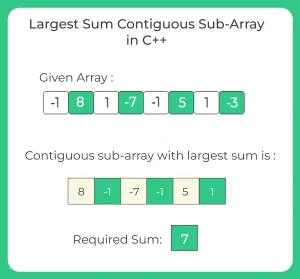Largest Sum Contigous SubArray in C++

Largest Sum Contiguous Subarray in C++
Here, in this page we will discuss the program to find the largest sum contiguous subarray in C++. We will discuss two different ways in this page for finding such subarray.
Largest Sum Contiguous Sub-Array in C++
The problem of finding the largest sum contiguous subarray in a given array involves identifying a subarray within the array that has the highest sum of its elements. This means we are searching for a continuous subarray in the given array that has the maximum possible sum.
For example, consider the following array:
arr = [-2, -3, 4, -1, -2, 1, 5, -3]
The largest sum contiguous subarray in this array is [4, -1, -2, 1, 5], which has a sum of 7.
The problem of finding the largest sum contiguous subarray has a well-known algorithm called Kadane’s algorithm. The algorithm has a time complexity of O(n) and can be easily implemented in C++.

Method Discussed :
- Method 1 : Brute Force Approach.
- Method 2 : Using Kadane’s Algorithm
Method 1 :
- Declare a variable say res = INT_MIN.
- Run a loop from index 0 to n.
- Declare a variable sum = 0;
- Run a nested loop from index i to n.
- Set sum += arr[j].
- And res = max(res, sum)
- After Complete Iteration print res.
Time and Space Complexity :
- Time Complexity : O(n2)
- Space Complexity : O(1)
Method 1 : Code in C++
#include <bits/stdc++.h>
using namespace std;
int main()
{
int arr[] = {-2, -3, 4, -1, -2, 1, 5, -3};
int n = sizeof(arr)/sizeof(arr[0]);
int res = INT_MIN;
for(int i=0; i<n; i++){
int sum = 0;
for(int j=i; j<n; j++){
sum += arr[j];
res = max(sum, res);
}
}
cout<<res;
}
Output
7
Method 2 :
- Create variable say max_sum that hold the required maximum sum of subarray and curr_sum and initialize max_sum with INT_MIN and curr_sum with 0.
- Now, iterate over the array, and for every ith value of the array, add it to curr_sum, and comapre it with max_sum like,
- if(max_sum < curr_sum) max_sum = curr_sum.
- Now, check if curr_sum <0 then set curr_sum to 0.
- After complete iteration we will get the result that store in max_sum variable.
Time and Space Complexity :
- Time Complexity : O(n)
- Space Complexity : O(1)
Method 2 : Code in C++
#include <bits/stdc++.h>
using namespace std;
int main()
{
int arr[] = {-2, -3, 4, -1, -2, 1, 5, -3};
int n = sizeof(arr)/sizeof(arr[0]);
int max_sum = INT_MIN, curr_sum =0;
for(int i=0; i< n; i++){
curr_sum += arr[i];
if(max_sum < curr_sum)
max_sum = curr_sum;
if(curr_sum < 0)
curr_sum = 0;
}
cout << max_sum;
}
Output
7
Prime Course Trailer
Related Banners
Get PrepInsta Prime & get Access to all 200+ courses offered by PrepInsta in One Subscription
Get over 200+ course One Subscription
Courses like AI/ML, Cloud Computing, Ethical Hacking, C, C++, Java, Python, DSA (All Languages), Competitive Coding (All Languages), TCS, Infosys, Wipro, Amazon, DBMS, SQL and others
Arrays
- Introduction to Arrays – C | C++ | Java
- Introduction to 2-D Arrays – C | C++ | Java
- Sorting of Array – C | C++ | Java
- Array Rotation – C | C++ | Java
- Reverse an array or string- C | C++ | Java
- Find pairs in array with given sum – C | C++ | Java
- Sort the array in Waveform – C | C++ | Java
- Majority Element in Array – C | C++ | Java
- Boyer-Moore’s Voting Algorithm – C | C++ | Java
- K-pairs with smallest sum in 2 arrays – C | C++ | Java
- Largest Sum Contigous SubArray – C | C++ | Java
- Maximum Average Sub-array of K length – C | C++ | Java
- Size of sub-array with max sum – C | C++ | Java
- Sub-array with given sum – C | C++ | Java
- Triplet that sum to a given value – C | C++ | Java
- Segregate 0’s and 1’s in array – C | C++ | Java
- Segregate 0’s 1’s and 2’s in array – C | C++ | Java
- Sort elements in array by frequency – C | C++ | Java
- Finding pythagorean triplets in an array – C | C++ | Java
- Reorder array using given indexes – C | C++ | Java
- Merging two sorted arrays – C | C++ | Java
- Minimum number of Merge Operations to make an Array Palindrome – C | C++ | Java
- Find Zeros to be Flipped so that number of Consecutive 1’s is maximized – C | C++ | Java






Login/Signup to comment